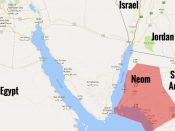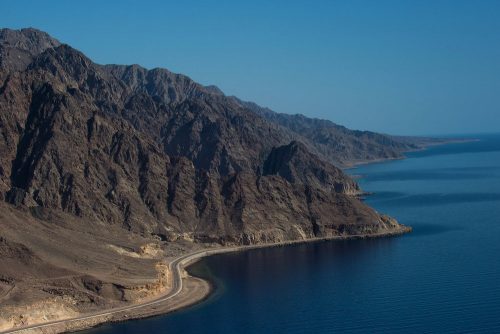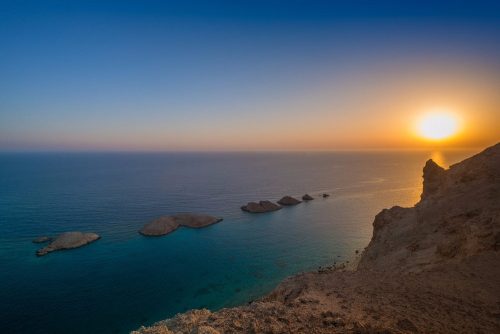

On Tuesday of last week, to a packed audience at a conference in Riyadh, Saudi Crown Prince Mohammad bin Salman announced the conception of a new mega city to be built in Saudi Arabia. Neom, which means “New Future” is an ambitious attempt by the Kingdom to propel itself upon the world stage by creating a new avant-garde city that implores state of the art innovation. According to promotional material, Neom will mark a new era in Saudi Arabia’s future and will be “A new future on Earth like nothing on Earth.”
It has long been asserted that cities will play an increasingly critical role in the economic viability of the global future. By announcing the creation of Neom, Saudi Arabia is looking to puts itself at the forefront of economic and technological innovation. The scope of this ambitious endeavor is unlike anything currently being developed in the world. With such a grand pursuit, the world should be taking notice of what the Saudi’s are looking to here and what the its success means for development of futures cities.
The Crown Prince noted that the city will be established in a remote location in the northwestern corner of the country, near its borders with Egypt and Jordan, more than 600 miles from either Jeddah or Riyadh, Saudi Arabia’s two largest cities. Egypt and Jordan have both committed to dedicate land to the city that will create a transnational zone that spans over 10,000 square miles. The city comes with a price tag of $500 billion which will come from the country’s sovereign wealth fund and private investment.

Neom is an example of Saudi Arabia’s desire to move the country away from an oil-based economy as part of its Vision 2030 plan. The city will establish a special economic zone that will “streamline” the cost of doing business in the country that circumvents the country’s typical bureaucracy. The projects website states that “Neom will be the world’s first independent special zone spanning three countries, with a regulatory framework designed to adopt world-class investment laws that support the livelihoods of residents and the development of targeted economic sectors.”[1]
The first phase of the city is projected to be completed by 2025. Neom will focus on nine key economic sectors as guidelines to chart its development: energy and water, mobility, biotechnology, advanced food production, technological and digital sciences, advanced manufacturing, media production, entertainment, and quality of life.
Neom seems to be Saudi Arabia’s most ambitious plan to date towards economic diversification. So, the question arises, given their track record of mega city initiatives, can the Saudis pull off such a loft undertaking? In 2005, the late King Abdullah announced the Economic Cities initiatives that sought to establish four independent economic zones within the kingdom to increase the economic viability of the country and transition the country away from oil; the same goal driving the creation of Neom. Chief amongst these cities is King Abdullah Economic City (KAEC) which sits along the Red Sea and is about an hour and a half drive north of Jeddah, Saudi’s second largest city.

Unlike Neom, KAEC has significant demand generators that can support the ambitious development of a new city. In addition to its location near Jeddah, KAEC built one the world’s most advanced ports to take advantage of the shipping traffic along the Red Sea. It also sits along the new Haramain Highspeed Railway, a railway project that reduces travel time between Islam’s two most holy cities, Mecca and Medina. With Mecca to the south and Medina to the north, KAEC expects to serve as a tourist destination appealing to the 8 million people who visit Saudi Arabia each year for the annual hajj pilgrimage. KAEC is also home to the Prince Muhammad bin Salman College of Business of Entrepreneurship, a premiere business school established in collaboration with Babson College, one the premiere schools for entrepreneurship in the US. The city is also only a 30-minute drive from King Abdullah University of Science and Technology, which is one the world’s fastest growing research universities and has one of the world’s largest endowments.
KAEC covers an area of 70 square miles, about the size of Washington DC and was expected to have a population of 2 million by 2030. In the twelve years since its initial conception and despite having significant demand generators in close proximity, the city is far behind its expected growth. Currently, KAEC only has about 5,000 permanent residents. By comparison, Neom is far more ambitious. The new city is projected to be the size of 23 Hong Kongs with the first phase projected to be completed by 2025 in an area of the country that has little in the way of existing infrastructure.

It also remains to be seen how the independent economic zones differ from those established in the economic cities and what this means for investors. Saudi Arabia has long been a country dominated by societal conservatism that has at times made it less conducive to foreign investment compared to its neighbors in the region. The economic cities were established to make the country more attractive to outside investment and establish investment incentives not seen elsewhere in the country, such as the foreign ownership of land. Neom says that “The special zone will also adopt an autonomous judicial system subject to independent regulations and legislation, which will be drafted by investors in accordance with international best practice. The zone will be independent of the Kingdom’s existing governmental framework, excluding sovereign laws.”[2]
With Neom, Crown Prince Mohammad is asserting his legacy as the future king of a country attempting to evolve towards a more progressive future by building a city completely different from anywhere else in the country. And perhaps this is why he has chosen such a remote location for his new city. The world will have to wait and see how such an ambitious project takes shape and what that means for the future of Saudi Arabia. If the vision of the Crown Prince comes to fruition it will put the Saudi kingdom in a position on the world stage that it has never had by making it the embodiment of what future cities should aspire to.
[1] http://discoverneom.com/content/pdfs/NEOM_FAQS_ENGLISH.pdf
[2] http://discoverneom.com/content/pdfs/NEOM_FAQS_ENGLISH.pdf
